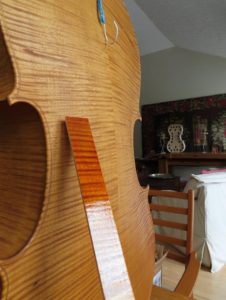While there is no way I could cover even an overview of violin family instrument varnish in a single blog post, it’s been on my mind this past week. Several of the makers we work with either send me pictures of the instrument in various stages of construction, or post the pictures on social media. Apart from working with my friends and customers, seeing the stages of a new instrument being built is one of my favorite parts of my job. Without taking the analogy too far, it reminds me of seeing ultrasound images of my daughters – snapshots of the progress as the anticipation builds towards actually holding the instrument (baby) in my hands.
While enhancing the beauty of the instrument, the purpose of the varnish is primarily to protect the wood from the environment. It also has an impact on the sound of the instrument. I’ve had the opportunity to play a “white” instrument (unvarnished) both while it is unvarnished and after the varnishing process. The difference is profound but not necessarily easy to describe. Varnish can be oil based or alcohol based, pigmented or unpigmented, etc. The variations of color, texture, and antiquing are limitless. Beautiful!
This is a picture of a cello being built by Eugene Holtier of Cleveland, OH. He’s completing the “ground” coats of varnish with a sample piece of maple held up to indicate the color of the instrument once all the coats are complete.


Recent Comments